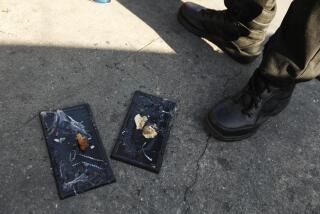By City Order, Snakes Lose Their Venom
- Share via
Herpetologist Richard Ritchey gingerly laid out the tiny white venom sac he had surgically extracted from an unconscious forest cobra.
“There’s enough [venom] in here to kill at least 10 people,” said Ritchey, one of only a handful of people in the nation capable of performing the surgery.
“It’s a serious operation, but as far as stress goes, this animal will eat tomorrow.”
Minutes later, the now harmless snake began moving on the table and flicking its forked tongue.
The procedure was one of three the Oregon reptile expert planned to conduct Friday at Wildlife Educators of America, which operates the nonprofit Fillmore Museum of Natural History, which opened in July and is home to 15 poisonous snakes.
The venom sacs of all 15 were removed over three days this week. The patients included a green mamba, considered one of the most aggressive and dangerous snakes in the world.
The surgery was mandated by the city after a nonpoisonous, harmless snake escaped from the Central Avenue museum several months ago and ended up in the yard of City Clerk Noreen Withers.
The snake escaped after museum volunteers failed to fasten the lid of its container securely, said Karl Anderson, executive director of the organization.
“There was certainly a valid concern that if something nonvenomous could get out, certainly something venomous could,” Anderson said.
The snakes are part of the museum’s collection of more than 200 stuffed animals and 50 live critters, ranging from tarantulas to hedgehogs.
The museum is open to the public on weekends. Anderson has about 60 more animals, including five wolves, a Siberian tiger and a black bear, on a 120-acre ranch between Fillmore and Santa Paula.
Anderson and his organization have been under scrutiny since the city lent him $98,000 in redevelopment money to open the museum in a former 6,000-square-foot grocery store in an effort to attract tourists to the community.
It was discovered that Anderson had spent two days in an Oregon jail in 1994 for keeping animals without a permit.
And later this month, Anderson will face charges that he failed to get valid permits for three of the dozens of animals he owns, something he acknowledges was “a mistake.”
The negative publicity has hindered the organization, which has attracted hundreds of visitors since the museum opened and is trying to raise tens of thousands of dollars for realistic dioramas that will include a walk-through cave and a living rain forest.
“I’m being made out to be the Godzilla of Ventura County,” said Anderson, who maintains that critics are overlooking the benefits of the museum.
“Teachers walk in here and say, ‘This is incredible. And who would have thought it would be in Fillmore?’ ”
Councilman Roger Campbell, who was instrumental in bringing the organization to Fillmore, said Anderson still has the city’s support.
“I don’t want to make light of what he did, because what he did was wrong,” Campbell said.
But he added, “We think the museum is a very viable thing.”
More to Read
Sign up for Essential California
The most important California stories and recommendations in your inbox every morning.
You may occasionally receive promotional content from the Los Angeles Times.













